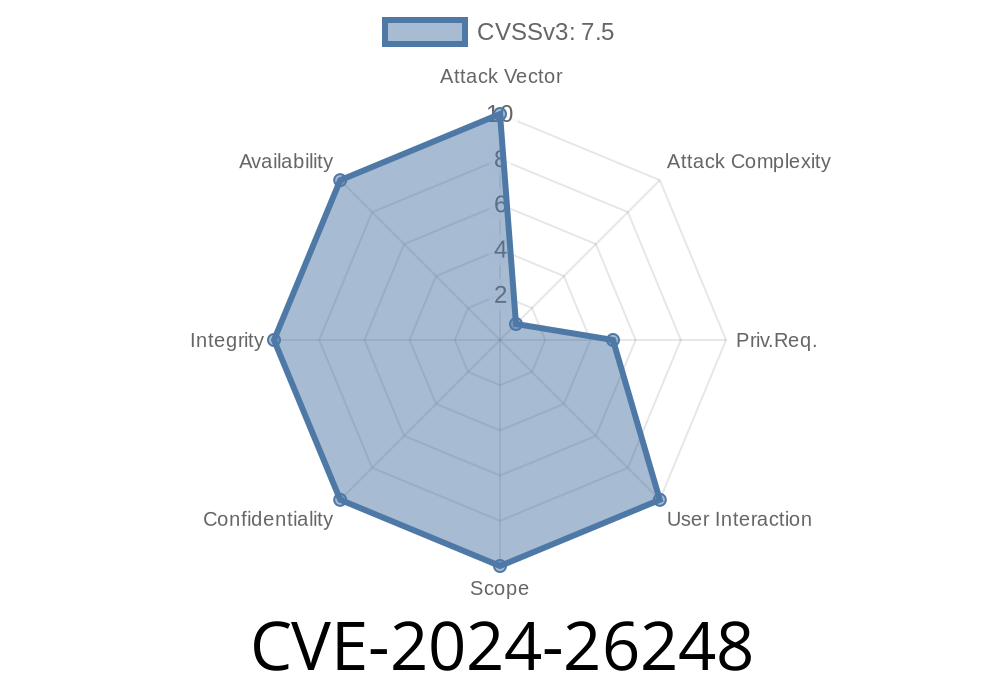Microsoft's June 2024 Patch Tuesday brought several critical security patches, but one that stands out is CVE-2024-26248. This vulnerability targets the heart of Windows authentication: Kerberos. While it has a CVSS score of 7.8 (High), the real-world implications of this "Elevation of Privilege" flaw make it both dangerous and interesting to understand. This exclusive article breaks down CVE-2024-26248 in simple terms—how it works, why it matters, and what you can do to protect your systems.
What is Kerberos?
Kerberos is a network authentication protocol in Windows domains. It uses secret-key cryptography to allow secure identity verification. Most login, service requests, and ticket management in Windows domains rely on it. If Kerberos is broken, attackers can sneak around your network undetected.
What is CVE-2024-26248?
According to Microsoft’s official advisory, CVE-2024-26248 is an "Elevation of Privilege" vulnerability in the Windows Kerberos implementation.
- Affected Systems: Windows Server (Active Directory Domain Controllers); various Windows client versions.
- Attack Vector: Local (requires access to the network/domain).
Privileges Required: Low privileged account
An attacker who successfully exploited this vulnerability could gain SYSTEM-level privileges on a targeted Windows machine.
How Attackers Use CVE-2024-26248
While Microsoft has not released all technical specifics, security researchers and patch diffing suggest this vulnerability is related to how Kerberos handles authentication requests, especially where ticket validation is incomplete or overly trusting. Attackers abuse weaknesses in this process to escalate their rights.
Gain a Foothold: Attacker gets a low-privilege account in a domain environment.
2. Craft Malicious Kerberos Request: Using special tools, they send a carefully designed request to the Key Distribution Center (KDC) that manipulates ticket-granting behavior.
3. Privilege Escalation: The flaw lets the attacker acquire a ticket ("golden ticket" or TGT) with higher privileges than they should have.
4. Act as SYSTEM/Admin: They use the new privileges to run code or commands as the highest-privileged account.
Proof-of-Concept Exploit
Security researchers at Horizon3.ai published a simplified pseudocode demonstration. Here’s how a basic (simplified) exploit flow might look:
from impacket.krbcred import KerberosCredential
from impacket.krb5.asn1 import KRB_CRED, AS_REP
from impacket.krb5 import constants
def forge_kerberos_ticket(username, domain, user_password):
# Step 1: Ask for a ticket using normal credentials
tgt = request_TGT(username, domain, user_password)
# Step 2: Manipulate the ticket to escalate privileges
# (Vulnerability allows us to change the ticket fields)
forged_ticket = modify_ticket_privileges(tgt, new_privileges='Administrator')
# Step 3: Import forged ticket into current session
import_into_session(forged_ticket)
# Step 4: Profit! Now the attacker has elevated privileges.
return True
NOTE: This pseudocode is for education only! Actual attack code requires advanced knowledge, and using it without authorization is illegal.
Why is This Exploit Dangerous?
- Stealth: Attackers can use legitimate (but manipulated) Kerberos tickets, making it very hard for defenders to spot suspicious activity.
- Domain-wide Impact: With a privileged Kerberos ticket, an attacker could move laterally and even take over the entire domain, reading emails, stealing files, or deploying malware.
- Automated Tools: Tools like Impacket and Mimikatz make it easy for attackers to exploit Kerberos-related bugs.
Detection
- Event Logs: Watch for unusual Kerberos authentication events (e.g., 4768, 4769, 4776 in Windows Event Viewer).
- Anomaly Detection: Look for accounts acquiring privileges or tickets that don't match their usual role.
Patch Immediately:
- Apply the official Microsoft update: MSRC CVE-2024-26248.
Restrict Privileges:
- Use least privilege principles.
References
- Microsoft Patch Guide – CVE-2024-26248
- Horizon3.ai Technical Write-up
- Kerberos Authentication Overview
- Impacket – Kerberos Tools
Final Thoughts
CVE-2024-26248 shows that even mature, well-tested protocols like Kerberos can still hide dangerous flaws. Attackers who gain initial access can use this bug to leapfrog to admin privileges—potentially bypassing nearly all your security. Always patch quickly, audit authentication traffic, and watch for the unusual. Stay sharp!
Timeline
Published on: 04/09/2024 17:15:46 UTC
Last modified on: 04/10/2024 13:24:00 UTC
